Popular searches
Items per page
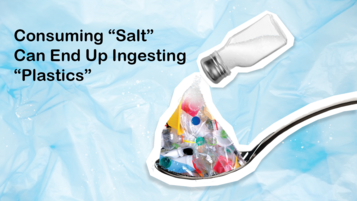
- 2020.08
- Trivia
- Food and Cooking
Consuming “salt” can end up ingesting “plastics”
What is microplastic? According to an article from the European Food Safety Authority (EFSA) in 2016, microplastics are mixtures of particles in various shapes and types, including fragments, fibres, spheres, pellets, granules, films and microbeads with size ranging from 0.1 to 5,000 micrometres(μm). Microplastics can be further divided into two types: primary and secondary. Primary microplastics: plastics that are directly manufactured into the intended size, e.g., microbeads contained in cleansing scrubs. Secondary microplastics: plastic fragments that are created from the breaking down of larger plastic products through processes such as wave erosion, photodegradation and biodegradation. In the edible salts that were found to contain microplastics, the two most commonly found substances are poly(methyl methacrylate) (PMMA) and polypropylene (PP). Where do plastics in our food come from? Regardless of the type, microplastics are similar to sediments and zooplanktons in terms of size and shape, and thus cannot be completely eliminated by the existing sewage treatment systems. Microplastics can therefore be ingested by marine organisms and enter the food chain. At the same time, plastic food packaging also represents another possible source of microplastics. In the test samples of edible salts mentioned above, the microplastics found may have come from contaminated raw materials or the products’ plastic packaging. If the contamination comes from raw materials, then it may also be related to other factors such as level of contamination, utilization and recycling rate of various plastic products and the stability of their chemical structures under different heat level, UV exposure and oxidation level. The effects of microplastics on us The microplastics in food are capable of absorbing harmful chemical substances and releasing their own additives. While currently it is still inconclusive in relation to microplastics’ effects on human bodies, prolonged intake of these chemical substances would certainly do no good to our bodies. How to eliminate microplastics from our food? The simplest way is to tackle the root cause. If we can adhere to the principle of sustainable consumption by reducing the use of plastic products or switching to degradable plastic products, or explore measures such as expanding the plastic bags levy and increasing recycling rates etc, we would be able to reduce the harmful effects brought by plastic pollution on the environment and all creatures. This would ultimately benefit us all. If you still do not have an idea on how often microplastics can be found in our food, you may refer to the article: “Metallic Contaminants Detected in More than 60% of Edible Salts Presence of Micro-plastics in 20% of Sea Salts Showing Urgent Need for Plastic Reduction”. CHOICE Magazine, Issue 522. The Consumer Council tested certain edible salts in the market, and from the results we realize that we simply cannot overlook the impact of environmental pollution.

- 2020.06
- Features
- Home Appliances
- Green Living
Say Goodbye to High Electricity Bills! Choose These 3 Home Appliances Carefully
Tip on energy saving #1: Save energy while enjoying the cool breeze The first thing most people do when they return home on a hot summer day is to switch on the air conditioner. If you want to save energy in the long run while enjoying the cool breeze, you may want to spend a bit more and invest in an inverter type air conditioner! The more energy-efficient inverter type air conditioners may cost 15-20% more than the fixed capacity type, but despite being more expensive, consumers can save enough on electricity costs over 2 to 3 years to make up for the difference. This is because an inverter type air conditioner will run at a high speed when it is initially switched on, and then it will automatically reduce the speed when the room temperature is closer to the target temperature, thereby saving energy. When purchasing an inverter type air conditioner, you have to take into consideration factors such as room size and the actual environment. For example, if the unit is placed in a huge living room, make sure it has sufficient cooling capacity to prevent it from prolonged operation under maximum load, which will consume a lot of energy. Although the display of ‘Energy Label Grade 1’ can be an easy-to-understand energy efficiency indicator, air conditioners displaying the same ‘Grade 1’ labels may still vary in energy saving due to their differences in the Cooling Seasonal Performance Factor (CSPF). Therefore, consumers should also refer to the CSPF test results published by the Consumer Council (the ‘Council’). There are various models of air conditioners on the market. Which one is the most energy efficient? You may refer to the article ‘How to Save Energy While Enjoying the Cool Breeze? Air Conditioners with High Energy Efficiency Can Save 20% or More in Energy Costs’ (Chinese version only) in issue #487 of CHOICE Magazine. Choosing an energy-saving model is just the first step. Don’t forget to clean and maintain the air conditioner regularly in order to keep it in the most energy-efficient condition! Apart from electricity costs, you can also contribute to environmental protection and sustainable consumption by choosing the right air conditioner. We can use the Global Warming Potential (GWP) to assess the impact of refrigerant on the environment. The larger the number, the more likely it will cause global warming. R410A, the most common refrigerant at the moment, has a GWP value of 2,088. But the new R32 refrigerant has a GWP value of only 675, which significantly reduces the impact on the environment. To find out which air conditioners are more eco-friendly, please refer to the article ‘Review of 3/4 Horsepower Window-Type Air Conditioners. Models with Eco-Friendly Refrigerant Perform Better!’ (Chinese version only) in issue #523 of CHOICE Magazine. Tip on energy saving #2: Washing with warm water can be expensive Pay heed if you need to do laundry frequently as different models of front-loading and top-loading impeller washing machines may vary in energy consumption by as much as 80%! The first question you need to ask yourself is, ‘Do you really need to wash your clothes in warm water?’ Warm water at a certain temperature can indeed kill dust mites, decompose grease, and remove sweat odours. But other than that, the difference in cleaning performance between warm water and room temperature water is very small. In fact, room temperature water is more gentle on fabrics and can prevent fading and shrinking. If you don't have to use warm water for washing, then a top-loading impeller washing machine can help you to save. Although top-loading impeller models use room temperature water, their average cleaning performance is only slightly behind front-loading models which use warm water. Surprisingly, some top-loading impeller models even achieve better cleaning results than some front-loading ones! On the whole, top-loading impeller models without heating function consume 80% less in energy than front-loading ones. Also, their spin speed is lower, and the washing process takes less time as well. However, it should be noted that top-loading impeller models consume more water. Don't forget that your washing machine is actually very high-tech! Before the wash, sort your laundry items according to fabric types and degree of soiling, then select the appropriate washing program. You may simply choose the ‘Eco’ program which is also a good way to save energy. In addition to energy consumption, you should also consider water consumption, noise level, size, etc., in order to choose the right washing machine that best caters for your needs. You may refer to the article ‘Top-Loading Impeller and Front-Loading Washing Machines, Which Type Saves More Energy and Water?’ (Chinese version only) in issue #488 of CHOICE Magazine. Tip on energy saving #3: Energy-efficient LED light bulbs...and extra energy-efficient LED light bulbs! You may have already replaced those tungsten light bulbs that consume more energy and heat up easily with the more energy-efficient LED light bulbs. But which LED light bulb is the most energy efficient version? It turns out that dim lights do not necessarily save more energy, and brighter light bulbs are not that energy-consuming! To find out if the light bulb is truly energy-efficient, one can't just look at its degree of ‘luminous flux’ but should also look at its ‘luminous efficacy’! ‘Luminous efficacy’ refers to the lumen output per watt of electricity. The larger the value, the better the energy efficiency. A light bulb with low luminous flux (i.e., low in brightness) and one with high luminous flux (i.e., high in brightness) can theoretically have the same ‘luminous efficacy’. The key is the amount of electricity they consume to produce the same luminosity. When selecting a light bulb, you can pay attention to its lumen (LM) output marked on its packaging. The higher the lumen output, the brighter the light bulb. If the LM output is the same, the one with lower wattage is more energy efficient because of its higher ‘luminous efficacy’. The Council tested 10 LED light bulbs on the market, including 7 conventional ones and 3 smart light bulbs. The 3 smart light bulbs claimed to emit up to 16 million colour rays, and users could adjust the color and brightness of these light bulbs through their ‘apps’. It was found that the ‘luminous efficacy’ of 2 smart light bulbs varied significantly under different colours. In addition to ‘luminous efficacy’, consumers should also consider the lifespan of the light bulbs. Nowadays, light bulbs on the market usually claim to have a lifespan of 15,000 hours to 25,000 hours. When the lumen output of an LED light bulb drops to 70%, it is generally regarded as being expired. From the test, 2 models could still maintain their original luminous flux after 6,000 hours of use, while the remaining 8 models scored slightly behind, with an average drop of 1.1% to 6.2% in luminosity. If you want to quickly find out if the LED light bulbs that you are using are energy efficient, you may refer to the articles ‘3 LED Light Bulbs Scored High in Luminous Efficacy and Energy Efficiency’ and ‘Choose the More Cost-Effective and Durable LED Light Bulbs’ (Chinese versions only) in issues #512 and #521 of CHOICE Magazine. Energy conservation is a lifetime commitment. In addition to choosing high-performance, long-lasting and energy-efficient appliances, we should also try to change some of our habits. In recent years, there have been many innovative products and ideas, such as smart extension units. On the other hand, you can preset and switch off your air conditioner 1 hour before you get up in the morning, thus reducing energy consumption. Some people said this method not only had helped them in terms of energy saving but also changed their habits of sleeping in. Do you have any unique idea on this subject? If so, please share with your family and friends!
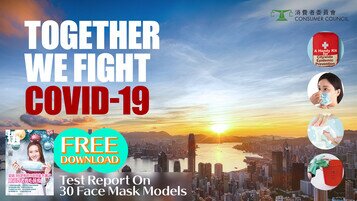
- 2020.04
- Features
- Health and Beauty
Together, We Fight COVID-19
Purchasing and Using Multipurpose Disinfectant Sprays – Facts Unpacked 【Mag Lam × Face Mask Testing】How Effective is Your Mask? DIY Face Mask – 8 Steps for Making Protective Gear Reuse Mask? DIY Mask? A Quick Glance on How to Choose Sterilized Disinfection Alcohol Alcohol Test - Is Sterilized Disinfection Alcohol Toxic? Special Feature on Chargeback Compensation Flight Ticket – Cancellation/Extension/Refund What you need to know about credit card chargeback? Treat pets well in the epidemic 10 Must-read Tips for Using Bleach In the meantime, a series of useful information on personal and household hygiene as well as updates on COVID-19 will also be provided. The Council is committed to working with people from all walks of life to tackle the novel coronavirus and safeguard public health together! Never re-use surgical masks! Is COVID-19 covered by insurance? A Handy Kit for Citywide Epidemic Prevention Don’t Stockpile Toilet paper Tips on Using Disinfectant Alcohol Maintain U-shaped Trap in Drainage Pipe Properly Do Not Use Industrial Alcohol to Make Hand Rub [PDF] Result Table on Comparative Test of Disposable Masks The articles below are only available in Chinese. Please click the links to download. [PDF] 花錢求心安?除菌掛卡掛章七大疑點 [PDF] 6款消毒酒精含有毒甲醇 逾8成濃度或容量不足 [PDF] 新型冠狀病毒快速測試存「假陰性」風險 勿胡亂自行檢測 [PDF] 社交平台網站購防疫用品風險高 保持理性免招損失 [PDF] 測試29款口罩 3款過濾細菌效率高於99.9% [PDF] 檢視37款消毒搓手液及濕巾 部分成分安全性受關注 [PDF] 多款洗手液驗出可致敏防腐劑或污染物 殺菌效能高下懸殊 [PDF] 漂白水濃度不足 1比99消毒殺菌成疑? [PDF] 如何揀選酒精消毒用品 [PDF] 5款廚房紙含菌量超標 吸水量參差 [PDF] 3款盒裝面紙韌性好吸濕快 每盒張數可相差逾100張! [PDF] 全城抗疫 個人家居衞生必讀貼士 Hotline of The Centre for Health Protection: 2125 1122 (8am to midnight) The Centre for Health Protection – Local Situation Dashboard More information will be uploaded soon ...

- 2020.03
- Leisure and Entertainment
Flight Ticket – Cancellation/Extension/Refund
For example, consumers who reserve flight tickets through travel agencies, it is possible that travel agencies may charge administrative fees according to the terms even if the airlines allow full refund in response to special circumstances; if the airlines decide to let the flights take off as scheduled and thus refuse to refund or offer trip extension, one must also consider the risk and do not rush to depart. In addition, the purchase of only flight tickets from licensed travel agencies in Hong Kong is not covered by the Travel Industry Compensation Fund. Only those travel packages covering both flight tickets plus hotels or attractions from licensed travel agencies in Hong Kong would be entitled to the stamps issued and protected by the Travel Industry Compensation Fund. For more information, please go to : Special Feature on Chargeback Compensation Together, We Fight the Virus
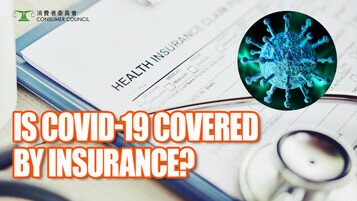
- 2020.03
- Leisure and Entertainment
- Life and Financial Planning
Is COVID-19 covered by insurance?
1: Is there a cash benefit for infectious diseases? The insured person is forced to be quarantined during the journey or within 7 days after returning to Hong Kong due to suspected or confirmed infection with infectious diseases, the insurance company will provide the insured with cash benefits in accordance with the terms based on the number of quarantine days. The insured must present documents proving such mandatory quarantine is required by the government agencies for infection or suspected infection. 2: Is there a medical hospitalization benefit after infection? Not necessarily. The insured person should be aware that insurance policies generally have non-insured clauses. If the insured person has purchased the travel insurance and the destination has been declared as an epidemic area by the "government" or "World Health Organization", it is likely that the insured person will not be able to enjoy such medical protection. 3: Is there any compensation on the cruise? As far as travel insurance is concerned, if travelers are suspected or confirmed to be infected with the novel coronavirus and are therefore forced to be quarantined on a cruise ship / designated quarantine premises, general travel insurance provides mandatory quarantine cash benefits. However, if the passenger changes or cancels the original mooring port due to this situation, it is not the designated risk of cruise travel insurance. In the event where the cruise company has canceled the original mooring port purely on precaution, it is the service provider's failure to provide services and is generally not insured. Passengers should check with the operator for a refund or compensation. As of early March, the Consumer Council has not received any complaint about refusing to provide "quarantine cash subsidies due to infectious diseases" to customers who were required to quarantine on cruises. 4: Does travel insurance cover the novel coronavirus pneumonia? The Government has included "Severe New Infectious Pathogen Respiratory Disease" (ie Novel Coronavirus) as a statutory notifiable infectious disease on January 8 to strengthen surveillance. Consumers need to be aware of whether infectious diseases are covered by the policy terms. The insured person should be aware that there is a chance that the designated body ("Government" or "WHO") has not published the designated area and the insured person has not obtained the desired protection. In May 2018, the Consumer Council published a survey report on travel insurance. It reviewed the policy terms of the 16 insurance companies obtained at the time and came to the following observation: 11 companies' policies define "Infectious Disease" 7 required infectious diseases that have been transmitted from person to person and that have been widely spread among the local population by the World Health Organization. 3 required infectious disease-related information to be announced by the “government” and require quarantine. 1 prescribed infectious disease must be published by the "Hong Kong Government" under the Prevention and Control of Diseases Ordinance, Chapter 599 of the Laws of Hong Kong. 5 companies' policies do not define "infectious disease" 5: Is it protected if the trip is canceled due to travel alert? Many travel insurance policies provide different levels of protection for black/red/yellow outbound travel alerts, such as cancellation of the itinerary, or cash allowance on travel alert. If the Hong Kong government issues travel alerts to other regions/countries, some travel insurance policies provide compensation for cancellations and usually cover some non-refundable travel costs. However, it must be noted that as some insurance companies have already established the widespread of this new type of coronavirus as an existing risk, insurance policies purchased after a certain date may not provide compensation even if they are protected by outbound travel alerts. Details are subject to the terms of the policy. The insured should first ask the tour operator for the cost of canceling the itinerary. The expenses that cannot be recovered can be claimed from the insurance company according to the terms of the insurance policy. (From the Hong Kong Insurance Association) 6. Is it covered by the insurance if one infected at the destination? If the insured person is unfortunately infected with the novel coronavirus at the destination during the tour, it is required to go to a local registered hospital for medical treatment to be covered by overseas medical expenses. If the itinerary is changed accordingly, additional accommodation and transportation costs will be covered. If the insured person is unfortunately infected with the novel coronavirus before the trip and is unable to depart, travel protection will be covered. As the products of different insurance companies are different, the policyholder should pay attention to the terms of the policy. They may also check with the intermediary or insurance company. (From The Hong Kong Federation of Insurers) 7: Is it covered by insurance if one has to cancel the trip or quarantine at home? If the trip is canceled due to the epidemic, please pay attention to the following protections: The 14 company policies surveyed will provide travel cancellation protection for the insureds who need to undergo mandatory quarantine, but there are also individual policies that do not provide protection for "quarantine at home"; the policies of 11 companies specify that when an unexpected outbreak of an infectious disease suddenly occurs at the destination of the planned trip within 7 days before the scheduled departure date, the insured can be protected if the trip is canceled. Do take note that the clause generally only covers emergencies at the destination of the trip, which it has to reach "emergency" and "unforeseeable" situations, such a case does not apply in Hong Kong. If the insured person has purchased the travel insurance, the destination of the itinerary has been declared an epidemic area by the "Government" or "World Health Organization", the insured person will probably not be protected. Please visit “Together, We Fight the Virus” webpage of the Consumer Council to understand the remedial measures of various insurance companies regarding the outbreak of the novel coronavirus: Together, We Fight the Virus CHOICE Facebook Fanpage Consumers may also browse the webpage “Insurance Dashboard on COVID-19” provided by The Hong Kong Federation of Insurers to learn more information.
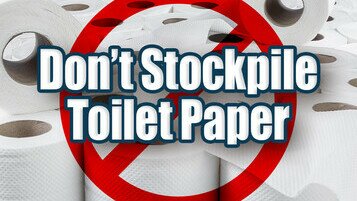
- 2020.02
- Features
- Health and Beauty
Do Not Stockpile Toilet Paper
Consumers should note that although there are wrappings on individual rolls as well as on the whole packing, toilet paper will still be exposed to moisture if the wrapping is damaged, resulting in the growth of mould and bacteria. Therefore, please do not stockpile toilet paper. For storage, please keep them in a clean, cool and dry place and not in the bathroom as moisture would adversely affect the quality of the toilet paper. In fact, toilet paper suppliers have already announced that stock was abundant and the supply was well maintained. There is no need to panic. Browsehereof the Council to look for more information on epidemic prevention.
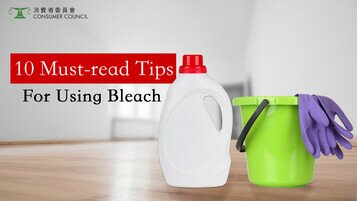
- 2020.01
- Tips
- Health and Beauty
- Home Appliances
10 Must-read Tips for Using Bleach
1/ Will bleach expire? From a test conducted by the Council, the concentration of sodium hypochlorite of some brands was lower than its claim. Manufacturers explained that sodium hypochlorite may decompose with time, leading to the instability. Although some will add stabilizers in the product formulas to slow down decomposition, consumers should pay attention to the production or expiry date of bleach before purchase. For example, there are label instructions specifying its expiry period of 3 years. 2/ Big difference in concentration of bleach? The Department of Health has drawn public attention to the baseline of Sodium hypochlorite concentration, which is 5.25% when preparing 1:99 or 1:49 diluted household bleach (i.e. mixing 10ml of bleach to make a 1 liter or 0.5-liter solution). However, from a test conducted by the Council, 15 out of 22 product samples were found to contain a lower concentration than that. Therefore, consumers should read and find out the concentration of sodium hypochlorite specified on the product label. Past reference available in Chinese:Issue 393 of CHOICE Magazine 3/ When we need 1:49 or 1:99 diluted bleach? For bleach containing 5.25% sodium hypochlorite, properly dilute the bleach to achieve appropriate concentration as follows: 1 to 99: 1:99 diluted household bleach (mixing 1 part of 5.25% bleach with 99 parts of water) is used for general household cleaning and disinfection; 1 to 49: 1:49 diluted household bleach (mixing 1 part of 5.25% bleach with 49 parts of water) is used for surfaces or articles contaminated with vomitus, excreta, and secretions; 1 to 4: 1:4 diluted household bleach (mixing 1 part of 5.25% bleach with 4 parts of water) is used for surfaces or articles contaminated with blood spillage. 4/ How to calculate the diluted concentration? If the sodium hypochlorite concentration of bleach is above or below 5.25%, then make adjustments to the amount of bleach. Calculation: Multiplier of the amount of bleach added = 5.25 / concentration of sodium hypochlorite in bleach. For example, when diluting a bleach-containing only 5% sodium hypochlorite, the multiplier is 5.25 / 5 = 1.05. That means 10ml x 1.05 = 10.5ml of bleach should be used when preparing a bleach solution. 5/ Use the bottle cap to measure the amount of bleach? Do not use the bottle cap for measurement of the amount of bleach for convenience. The Council’s survey revealed that the volume of bottle caps varied greatly among the samples. For instance, for product samples of 2 liter or below, the cap volume ranged from 8 to 40 ml, representing a difference of 4 times! While those of 2 liter or above showed a range of 8 to 15 ml. It is suggested to use a tablespoon or measuring cup for accurate measurement of the amount of bleach added, or find out the actual volume of bottle cap in advance to achieve appropriate concentration. 6/ Mix with other detergents to enhance its efficacy? Not really! On the contrary, chemical reactions may greatly reduce its oxidizing power, resulting in the loss of its bleaching and sterilizing capability. For example, a toxic gas is produced when bleach is mixed with acidic detergents or those used for toilet cleaning. This can result in accidents and injuries. It is recommended to use detergents first and rinse thoroughly with water before using bleach for disinfection. 7/ Bleach can serve all-purpose? Avoid using bleach on metals, wool, nylon, silk, dyed fabric, and painted surfaces. Except for stainless steel, do not wipe or soak metal products with bleach. In addition, do not pour high-concentration and undiluted bleach down a drain to avoid damaging the metal pipes, which will result in leakage. 8/ Dilute the bleach in bulk? For effective disinfection, diluted bleach should be used within 24 hours after preparation. The longer the storage time, the larger the amount of sodium hypochlorite decomposes. 9/ Stock up on bleach? Should not stock up on bleach. Undiluted bleach liberates a toxic gas when exposed to sunlight, thus store in a cool, shaded place and out of reach of children. Moreover, sodium hypochlorite decomposes with time. To ensure its effectiveness, purchase recently produced bleach and avoid over-stocking. 10/ Use and store bleach with caution? Since the bleach will irritate mucous membranes, the skin and the airway, put on appropriate personal protective equipment (e.g. mask, gloves, safety goggles, and plastic apron) and ensure good ventilation when diluting or using bleach. Avoid contact with eyes. If bleach gets into eyes, immediately rinse with water for at least 15 minutes and consult a doctor. Source: Combined information from Issue 319 of CHOICE Magazine (2003/05) and website of the Centre for Health Protection: The Use of Bleach



